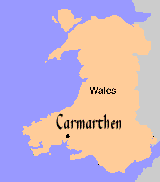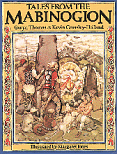
Explorations in ArthurianHistory
A Literature ReviewPart 1: Tales of Wales
Explorations in ArthurianHistory
A Literature ReviewPart 1: Tales of Wales It starts with poems. It starts with the Welsh, in the town of Carmarthen, reputed birthplace of Merlin. A firmer mention of Arthur can be found in a surviving manuscript, the Black Book of Carmarthen, which gives us tantalizing possibilities but only one historical clue: the Battle of Llongborth, the location of which can no longer be pinpointed. Arthur is mentioned by name as having been there. Other mentions of a man called Arthur within the poems of the Black Book include a tale of his trying to gain entrance to the castle guarded by Glewlwyd Gafaelfawr. He is also mentioned in the "Stanzas of the Graves," another poem included in the Black Book. The poem mentions his grave but says that its location is not known. This concept would grow into the notion that Arthur wasand isthe Once and Future King, who will come again to lead his people to victory over their oppressors. A fleeting reference to Arthur's greatness is contained in Y Gododdin, a poem by Aneirin extolling the braveness of the Gododdin, a tribe who migrated from Scotland to Wales, in a stand against the Angles at Catterick. To wit, the poet signs the praises of 80 warriors, one of whom he says fought bravely and did many brave deeds, "even though he was no Arthur." To discover more of Arthur in the Welsh tradition, we turn to the bard. Mythical tales featuring Arthur abound. Two othersare the "Dream of Rhonabwy" and "Culhwch and Olwen," both included ina late 14th-century work called the Red Book of Hergest. Lest we get the idea that all Welsh literarypictures painted of Arthur were favorable, let's take a brief look atthe Life of St. Cadoc, written by Lifris of Llancarfan. This11th-century tome portrays Arthur as prone to debauchery andpettiness. Two other early sources, the Life of St. Carannogand the Life of St. Padarn, teach Arthur a lesson in religion:In both stories, Arthur serves as an obstacle to the intended actionand is forced to admit the power of God. Finally we come to theLife of St. Gildas, whose De Excidio Britannium makesno mention of Arthur but does mention BadonHill. The Life of St. Gildas was writtenby the Llancarfan monk Caradoc about 1130; it portrays Arthur as"king of the whole of Britain" and introduces the abduction ofGuinevereby King Melwas and the rescue by Arthur. In this version, though, itis mediation by Gildas and other monks from Glastonbury that securesGuinevere's release. The abduction of the queen would become afamiliar theme. Speaking of familiarity, The Mabinogion and its four branches contain 11 tales from the Red Book of Hergest (including the "Dream of Rhonabwy" and "Culhwch and Olwen") and a story of Taliesin. These three are of particular interest as evidenced above. The Mabinogion also contains a tale of Peredur, which seems to have been the basis for later tales of Perceval. Other fun characters in these tales are Pwyll, Rhiannon, Branwen, and Math. As it began, so it endswith Merlin. Now, on toGeoffrey of Monmouth, the greatest Merlin biographer of the MiddleAges. Click hereto continue.

The Book of Taliesin, containingpoems written by and about the famous bard, provides some obliquereferences and one direct reference: The Spoils of Annwn,which tells of Arthur's traveling to the land of Annwn(the "fort of glass") to secure a magical cauldron and a magical sword. 


Also naming Camlann is the AnnalesCambriae (Annals of Wales), which says the Battle of Camlann was fought in 539, 21 years after the Battle of Badon Hill. It is from the Annales that we get the phrase"where Arthur and Medraut perished." The Annales also makes mentionof a battle called Arfderydd in 575, after which "Myrddin went mad."This battle and subsequent madness of Myrddinare also mentioned in the Black Book of Carmarthen. The number three has a particular significance in Welsh literature, as evidenced by the Triads, which contain several references to Arthur, including the Three Chieftains of Arthur's Court, The Three Counseling Knights, and the Three Knights of Battle. Arthur is also portrayed unsympathetically in such Triads as the Three Red Ravagers and the Three Powerful Swineherds. One Triad of note is the Three Futile Battles, which names as one of these Camlann. 

Explorations in Arthurian History andLegends
MainPage Other
© 2000-2009 David White